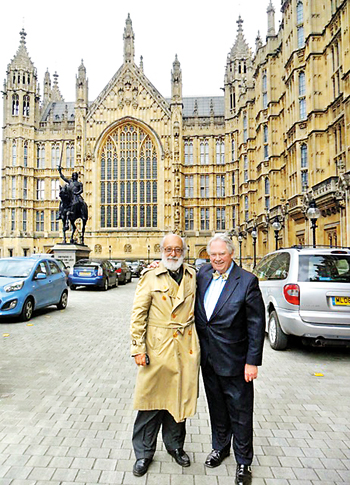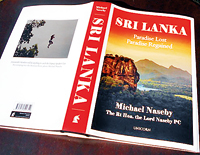For anyone interested in this country, politics and human nature
View(s):
Lord Naseby (right) with Royston Ellis outside the House of Lords
This book by Lord Naseby, who lived in Sri Lanka from 1963 to 1964 when he was Michael Morris and an eager South Asian Marketing Manager for Reckitt & Colman, has a cover with an eye-catching red spine proclaiming “Sri Lanka” in large type. It is clearly designed to attract bookshop browsers and to ensure that it becomes a prominent addition to an enthusiast’s collection of contemporary literature about Sri Lanka.
To declare an interest, I met Lord Naseby, then Michael Morris, more than 35 years ago when he was a Conservative Party member of the British Parliament. He was a fellow passenger on an Air Lanka flight to Colombo. We became friends and he often visited me at my bungalow during his subsequent visits to this country. On one occasion, he met my new houseboy, a Tamil from Jaffna, who had come to the south for work just after the civil war ended, and interviewed him with great interest about conditions in Jaffna. His continuing quest for the truth prevails in this book.
I was astonished to learn, when reading the acknowledgements, that Naseby credits me with giving him the idea to write this book about his long and impassioned involvement with Sri Lanka. I’m so glad he persevered to produce what is a fascinating insight to a caring politician’s life, his causes and his dedication to Sri Lanka.
Michael Morris had a distinguished career in Parliament from 1974 and, although he didn’t become a minister, he was Deputy Speaker from 1992 until 1997 when he became a member of the House of Lords as a Life Peer.
Lord Naseby can be forgiven for borrowing part of his book’s title from the 17th century epic poems by John Milton: “Paradise Lost, Paradise Regained” as he sees it as apt, even if many Sri Lankans may disagree with the assumption that paradise, although lost, has been regained.
His interest in this country began when he worked here when Sri Lanka was Ceylon and he had nothing to do with politics.In Britain, he has continued to pursue this active interest throughout his Parliamentary career, espousing this country’s causes even in defiance of popular opinion in the UK.
For example, in the House of Lords as recently as January 2020, he declared that, “Sri Lanka is a great friend of this country. Thousands of its people were killed over the two world wars. It was one of the few countries to speak up in our favour over the Falklands. It faced a huge problem of a quasi 30-year war against the Tamil Tigers, which became a real war on 1 January 2009, covered by the international humanitarian law conditions, and lasted until 18 May.
“A year after that, the UN decided to set up a three-man mission to investigate. It did not take evidence on the ground in Sri Lanka but asked for submissions to be made. Those submissions have never been made public and are covered by a 30-year rule, so nobody knows what they really were. However, the UN slowly took a greater interest in what was happening in Sri Lanka and the net result was that, in March 2012, it set up a body under the UNHCR that is chaired today by the United Kingdom. Its role is to promote reconciliation and accountability in Sri Lanka. I make no argument about that. However, this has to happen in the context of the sovereignty, independence, unity and territorial integrity of Sri Lanka.”
Naseby’s concern for accuracy, evident throughout this book, prompted him to say in that debate in the House of Lords, “I have spent 10 years looking at the reports by Colonel Gash and the Tamil university teachers, and at the census and at all the coverage I could find. The net result is about 6,000 people killed, of which a quarter are Tamil Tigers. Despite all this, we now find that the UNHCR has decided that it wants to try to get war crimes pinned on the Sri Lankan army. Yet the reports of Colonel Gash made it clear that the army behaved admirably and looked after the civilians. If it had wanted to knock them off, then over 295,000 would not have been safely brought across the lines, would they? I believe that the time has come for the March review, when it takes place, to be the wind-up time for that phase of life in Sri Lanka.”
This book plays its part in what he calls ‘wind-up time’.
In her foreword to the book, Naseby’s Parliamentary colleague, Baroness Boothroyd, who knows Sri Lanka and Michael Naseby very well, states: “He saw and knew everyone of importance. He learned the aspirations of those in markets, the countryside and fishing villages…In the UK he campaigned objectively for a better understanding of Sri Lanka’s needs to combat the attempts to achieve a separate state by force through the Tamil Tiger terrorists.”
A second foreword is by Sri Lanka’s President 1994-2005, Chandrika Kumaratunga, who in 2005, presented Naseby with Sri Lanka’s highest award for foreigners, the Sri Lanka Ratna. She writes: “His deep commitment as well as his wide knowledge of the country and its peoples and the numerous friendships and trust he built with his genial and candid manner has, I believe, helped him to conduct whatever responsibilities he took on for Sri Lanka with success.”
Naseby’s connections and fascination with Asia began when he was at boarding school in England and shared a study with an Indian, Krishnan ( Kit) Srinivasan who later became Foreign Secretary in the Indian Civil Service. In 1955, Naseby stayed with his father, previously employed by the British government and who had been appointed as architect to the Punjab Government, in Lahore. This leads to the first of many surprises about Naseby in this book: after flying lessons in Pakistan, he went on to become a fully qualified Royal Air Force pilot with both RAF and NATO wings. Another surprise is to learn he secured an Economics degree from Cambridge before taking up a post of Assistant Sales Manager in Calcutta in 1962, accompanied by his doctor wife, Ann, and baby son. Just over a year later, aged 26, he was suddenly transferred as the company’s marketing manager, to Colombo.
His account of life in Sri Lanka begins with a brief guide to the country, covering his interest in politics being aroused by his acquaintance with Ananda Tissa de Alwis, before he returned to the UK in 1964. Another surprise: he began to restore old houses there and stood as a Conservative candidate for election in the Labour held seat of Islington North, gaining experience but losing, as expected. However, in 1973 he became a Member of Parliament and soon afterwards set up the All-Party British Sri Lanka Parliamentary Group which became – and still is – actively involved in understanding, maintaining cordial relations with, and promoting, Sri Lanka.
The book details political developments in England as well as in Sri Lanka over the past forty years, with asides about cricket, personal friendships, the Victoria Reservoir project, Maldives and much about the 2004 tsunami aid efforts, as well as including criticism of some NGOs.
The book reveals much about Lord Naseby, the man, particularly his persistence in pursuing accuracy (see the fascinating chapter about his efforts to get information from the British authorities under the Freedom of Information Act and his forthright comments on allegations of war crimes). It also highlights his knack of making friends. This helped him build up solid and trusting relationships with many who were (or became) in power and he could speak frankly with them, as they did with him. It’s this background to the past few decades of Sri Lanka’s history, that makes the book invaluable.
Naseby defines the Tamil Tigers as inspired by a “pure socialist revolutionary ethnic ideology to create a separate state. They had no interest in a democratic way of life.” Writing about the defeat of the Tigers, he cites proof that “there was no evidence of any form of genocide by the Sri Lanka armed forces.”His candidness allows him to criticise his own party leaders and the UN in their reaction to Sri Lanka’s plight. He debunks many reports about the way the war ended. Wind-up time, indeed.
Chapter 18, entitled “LTTE: Tamil Tigers and Other Groups Supporting Eelam” lists the horrors perpetrated by the LTTE. The final chapter, “Reflections”, contains this frank appraisal: “Time the West backed off and allowed the unitary state of Sri Lanka to fulfil its own destiny, based on ‘peace building’.” It contains a list of a dozen things that Lord Naseby considers timely “to create a real paradise”.
The book concludes with 50 pages of Appendices, being speeches, significant letters and five examples of the typically redacted pages that Naseby finally managed to obtainfrom the British authorities, as well as details of major British Parliamentary debates on Sri Lanka.
The serious tone of the book is relieved by the author’s gentle humour. The back cover, which features a photograph taken by Naseby of a boy jumping from a height into the Bentota River, carries the caption: “Honourable Members will do anything to catch the Deputy Speaker’s Eye,” a wry reference to his Parliamentary position.
Lord Naseby’s book is remarkable not only for the events it sets out in great detail, but also for the insights into political machinations in the UK and Sri Lanka. The difficult times of the past four decades are known to older Sri Lankans but not to the younger generation who would greatly benefit from reading this book.
In fact, the book should be required reading for everyone interested in this country, politics and human nature. We are privileged that Lord Naseby, determined to reveal the truth, has recorded history in the making in such a readable and memorable way.
“Sri Lanka: Paradise Lost, Paradise Regained” will be launched in Sri Lanka by Lord Naseby at the BMICH on April 3.
| Book facts | |
| Sri Lanka: Paradise Lost, Paradise Regained- by Michael (Lord) Naseby. (Unicorn Publishing Group, London; hardback, 335 pages; UK£20) Reviewed by Royston Ellis
|



